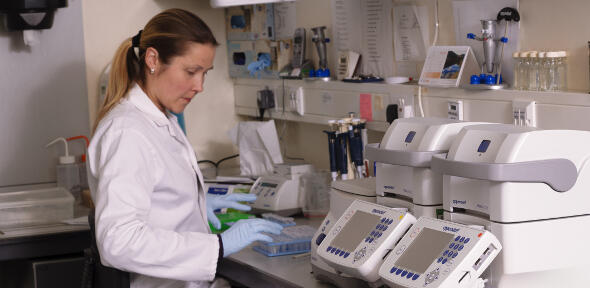Next-Generation Sequencing (NGS)

The facility is currently equipped with an Illumina NextSeq500 and two MiSeq sequencers, we can advise which of these will best suit your needs for sequencing of DNA or RNA samples. Depending on requirements, we can sequence user-prepared libraries or provide an extensive library preparation service. The facility has many years of experience in the use of exome, polyA selected, rRNA depleted and miRNA RNA-Seq and Chip-Seq methodologies, and we are continuously striving to broaden our skill base.
Services Available:
- Sample library preparation using Illumina kits (or others upon request)
- MiSeq and NextSeq500 Sequencing
- Bioanalyzer DNA & RNA analysis
- BluePippin DNA size selection
- Covaris DNA Shearing
Advantages of Our NGS Services:
- Highly experienced and qualified personnel
- State-of-the-art instruments and cutting-edge technologies
- Stringent quality control
- Personalized NGS solution to suit your research needs
- Professional strategy design
- Broad range of applications
- Competitive price
Sample Requirements for Library Preparation
- Nextera Library - at least 50 ng DNA at 2.5 ng/μl
- Nextera Mate Pair Library - at least 1 μg DNA at 15 ng/ul
- TruSeq PCR-free Library - at least 1 μg gDNA at 20 ng/μl for a 350 bp insert size or at least 2 μg gDNA at 40 ng/μl for a 550 bp insert size
- TruSeq Nano Library - at least 100 ng gDNA at 2 ng/μl for a 350 bp insert size or at least 200 ng gDNA at 4 ng/μl for a 550 bp insert size
- TruSeq RNA v2 Library - at least 0.1-1μg total RNA in 50 μl
- TruSeq stranded mRNA Library - at least 0.1-4μg total RNA in 50 μl
- Ribo-Zero rRNA removal - at least 1 μg total RNA
Input DNA Quantification
Follow these gDNA input recommendations from Illumina:
- Correct quantification of genomic DNA is essential
- The ultimate success or failure of a library preparation strongly depends on using an accurately quantified amount of input DNA.
- Illumina recommends using fluorometric based methods for quantification including Qubit or PicoGreen to provide accurate quantification for dsDNA. UV-spec based methods, such as the Nanodrop, will measure any nucleotides present in the sample including RNA, dsDNA, ssDNA and free nucleotides, which can give an inaccurate measurement of gDNA.
- DNA quantification methods that rely on intercalating fluorescent dyes measure only double-stranded DNA and are less subject to excess nucleic acids.
Assessing DNA Quality
Absorbance measurements at 260nm are commonly used to assess DNA quality:
- The ratio of absorbance at 260nm to absobance at 280nm is used as an indication of sample purity and values of 1.8-2.0 are considered indicative of relatively pure DNA.
- Both absorbance measurements can be compromised by the presence of RNA or small nucleic acid fragments such as nucleotides.
- Genomic DNA samples should be carefully collected to ensure that they are free of contaminants.
Gel electrophoresis is a powerful means for revealing the condition (including the presence or absence) of DNA in a sample.
- Impurities, such as detergents or proteins, can be revealed by smearing of DNA bands.
- RNA, which interferes with 260nm readings, is often visible at the bottom of a gel. If RNA is present, please treat the DNA with RNase A (DNase-free) and then purify, preferably using a column based method.
- A ladder or smear below a band of interest may indicate nicking or other damage to DNA.
- Where possible, or necessary, a gel should be run to assess the condition of the DNA sample.
RNA Input Recommendations
It is important to know the quality of the RNA starting material. The fragmentation conditions in the TruSeq RNA protocols were optimized for high-quality RNA.
- Illumina does not recommend the use of low quality or degraded RNA with these protocols. Use of degraded RNA can result in low yield, over-representation of the 3' ends of the RNA molecules, or failure of the protocol.
- Illumina recommends that you check total RNA integrity following isolation using an Agilent Technologies 2100 Bioanalyzer for samples with an RNA Integrity Number (RIN) value ≥ 8.
- RNA that has DNA contamination results in an underestimation of the amount of RNA used.
- Illumina recommends including a DNase step with the RNA isolation method. However, contaminant DNA is removed during mRNA purification.
Customer Prepared Libraries
We can sequence libraries prepared by any Illumina-compatible sample preparation kits. If you have prepared your own sequencing libraries, then we require at least 10 nM sample DNA in 10 μl. If you require sample de-multiplexing please provide us with the index sequences used.
To convert ng/μl DNA concentration to nM
[nM DNA] = DNA concentration (ng/μl) x 1e6 (μl/L) / (Sample fragment size in bp x 656.4 (g/mole))
Using Custom Primers
It is possible to use custom sequencing primers (Custom Primer for Read 1, Custom Primer for Read 2 or Custom Primer for the Index Read) for a run on the MiSeq and NextSeq by loading custom primers into the reagent cartridge.
You can also use a combination of custom primers and Illumina primers provided in the reagent cartridge. For example, you can use the Illumina primer for Read 1, a custom primer for the Index Read and the Illumina primer for Read 2.
Please supply custom primers at a stock concentration of 100 μM.


